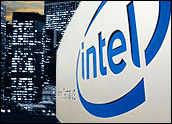
Shares of leading chipmaker Intel lost more than 7 percent in middaytrading Friday after the company’s stock was downgraded for a second time in a week.
JP Morgan analyst Christopher Danely downgraded the company on Friday, citing rising inventory levels at personal computer makers and a likely slowdown in corporate spending heading into the new year.
Slowing order rates could result in Intel coming in below or at the lower end of revenue and profit estimates during the first six months of 2008, Danely says in a research note.
Weaker Demand
Earlier in the week, Banc of America analyst Sumit Dhanda downgraded a larger basket of chip stocks — including Intel and main rival Advanced Micro Devices — citing weaker demand that could force price cuts to keep product moving.
Even without a recession in the U.S., the analysts suggested, fallout from the mortgage and commercial credit crunches will lead to less-robust business spending on technology for at least the first half of the year. While other markets may see more growth, rising demand for PCs from Europe, for example, will not be enough to entirely offset the weakness in North America, Danely noted.
Intel shares fell by as much as 8.5 percent Friday to US$22.55.
Mixed Outlook
Despite being downbeat on Intel, Danely dropped his forecast for the company’s 2008 profit by just 2 cents — from $1.68 per share to $1.66.
Meanwhile, Dhanda predicted that Intel will be among the companies that best weathers any slowdown in sales or buildup in inventory, with AMD and other smaller players likely to suffer more.
Research firms have begun to warn that 2008 will, at the very least, get off to a slow start for the chip sector. In part, that’s because chipmakers churned out certain kinds of chips — especially DRAM- (dynamic random access memory) and NAND-type flash memory chips — during the second half of 2007.
Last month, research firm iSuppli cut its forecast for 2008 growth from 9.3 percent to 7.5 percent, citing economic uncertainty as the main factor.
The firm now predicts global chip sales will reach $291.4 billion this year. Sales will actually fall during the first half of the year compared with a strong first six months of 2007, iSuppli said, in large part due to “very poor” market conditions for memory chips.
Worsening Conditions?
However, conditions could get even worse if the U.S. does slip into a recession, which could “scuttle the anticipated second-half recovery,” iSuppli said.
Meanwhile, Gartner predicts sales could fall between 3 percent and 7percent if a recession occurs in the U.S.
A decrease in total sales may occur even with robust demand from some markets and for certain kinds of chips, such as those in mobile phones and other consumer electronics devices, said Gartner analyst Martin Reynolds.
“As things start to slow, chipmakers are likely to start cutting prices to clear inventory,” Reynolds told the E-Commerce Times. “They need to keep their fabs working in order to get their investment back.”
Long-Range Optimism
Gartner separately predicted that spending on the equipment used to make semiconductors will drop sharply this year, with capital expenditures forecast to drop nearly 10 percent to just over $40 billion.
“Chipmakers are going to be cautious about adding new capacity in 2008,” Reynolds noted.
The long-range outlook remains more upbeat, with theSemiconductor Industry Association calling for sales to grow an average of 7.7 percent a year between now and 2010, when sales will reach $321 billion, compared with $247 billion for 2007.
Demand for chips for consumer electronics will more than replace any weakness in PCs over that period, SIA President George Scalise told the E-Commerce Times.
“The fact that chips are found in a growing number of consumer products and international growth is what will drive the industry for the next several years,” Scalise said.
Recessionary economic conditions could lead to short-term bumps in the road. Still, demand for consumer devices did not slump considerably in 2007, despite high energy prices and concerns about the housing market, Scalise pointed out.
“The industry’s history is to use innovation and the drive to build next-generation technologies to fuel growth even in the face of near-term challenges in regional economies,” he observed.






















































Social Media
See all Social Media